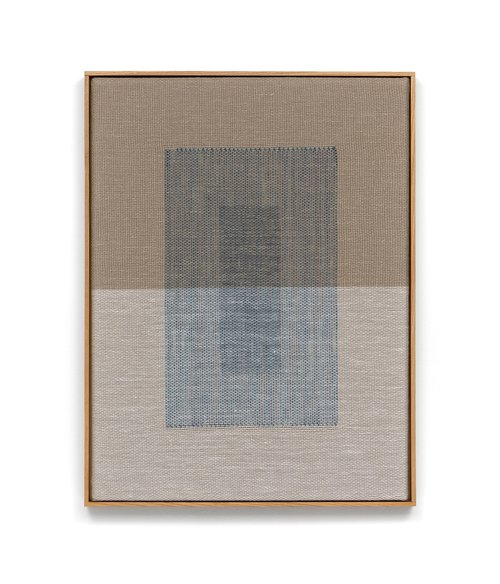
“Indigo Shadow,” handwoven linen, natural dyes, dye derived watercolor, 2022.
Dimensions are: 18″ x 24″
Image courtesy of: Rachel DuVall
Rachel Duvall is a textile artist that makes amazing hand-woven works. Based in Los Angeles, Duvall leans towards geometric designs that (courtesy of the artist’s web site), “explore the grid structure inherent to weaving, the result of the warp and weft fibers intersecting.” Using a repetitive pattern of line and shape, the compositions “produce a weaving and the flexible imperfect nature of the resulting material.”
Duvall’s almost scientific approach to repetition makes sense when the fine gradations of detail come through and the other variables fade away. Natural dyes and modifiers such as copper and iron allow the artist to “investigate the subtlety of colors.”
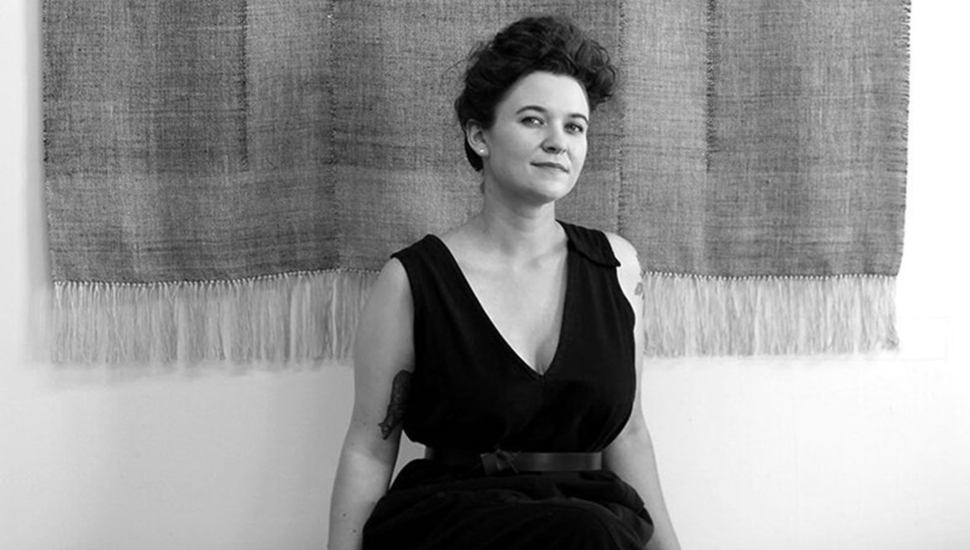
Duvall in front of one of her weavings.
Image courtesy of: Vista Today
Experimentation and investigation enabled Duvall to achieve a wide color palate that includes a purple from fermented lichen that comes from her backyard and a bright neon yellow. She likes using different types of dyes, including the traditional natural dyes such as indigo and cochineal.
Initially, Duvall explored the texture of raw alpaca fleece in her works; however these days, the artist solely uses in silk, linen, and wool. She keeps precise record-keeping, or recipes, of exactly how each hue was achieved. The folders in her studio contain swatches that are annotated with dye proportions and exact timing of how many minutes each item needs to remain submerged in a bath of madder root, for example.
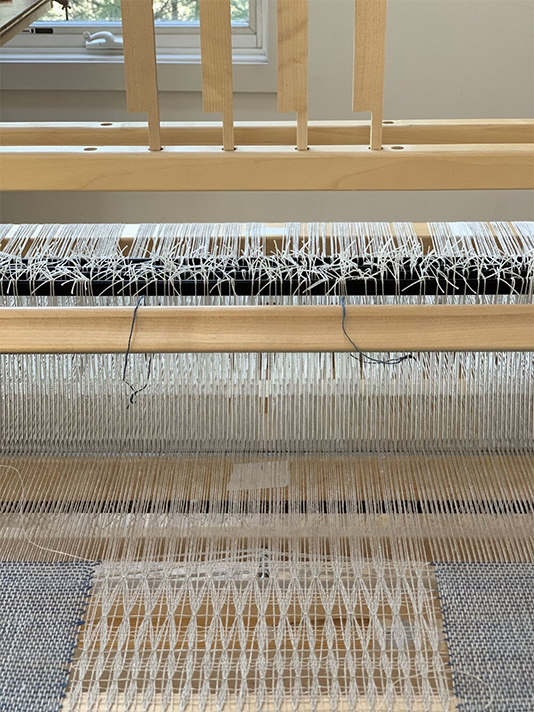
Duvall says that when she dyes material, she dyes enough for a number of pieces; however once she starts working on the loom, she only weaves one piece at a time.
Image courtesy of: Rachel Duvall
When she was in school, Duvall never considered that she might end up working in fiber… however, one class spent working on a floor loom got her hooked. It was the meditative practice behind weaving that felt like home to the artist. She says (courtesy of TL Magazine), “I love lining up all the threads and planning out the piece to then come out the other side with this flexible material. I really enjoy the balance between the inherent softness of a textile and its measured beginnings.”
Duvall is quick to point out that there are no “typical days” at her studio… some days she’s sketching, other days she dyes linen, at times she measures out a new warp for her loom. All of these steps must occur before Duvall actually weaves. She states that her work is very “process oriented;” meaning everything must be accounted for, inch by inch… only then can the weaving begin. Sketching enables Duvall to account for how much dye material she needs and how long the warp needs to be. Only once all of these calculations are made can work on the loom begin.
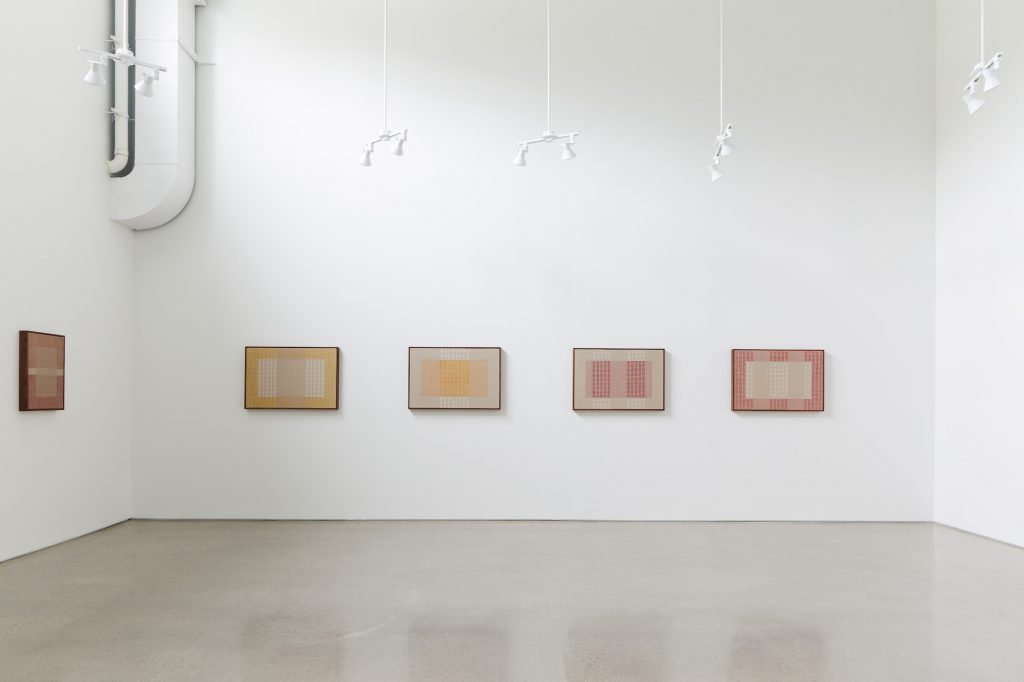
An installation view of Duvall’s “Off the Grid” from “Madder + Marigold.” Alison Milne Gallery, Toronto, 2021.
Image courtesy of: TL Magazine
Being an artist-in-residence at the Josef & Anne Albers Foundation in early 2020 allowed Duvall to really grow her practice. It was important for Duvall to take a short break from her regular work and to try new techniques. She started combining painting with weaving. Layering one material atop another was an entirely new look for Duvall, and one she is, rightfully so, quite excited about.
Perhaps it was the new environment or being able to explore the archives at the Foundation that spurred this new methodology? Maybe it was feeling inspired by the Albers’ work? Or it is conceivable that Duvall juxtapositioned the ideas behind Agnes Martin and Sol Le Witt’s works that pushed these new ideas and experimentations? For Duvall, there are just so many sources of inspiration.
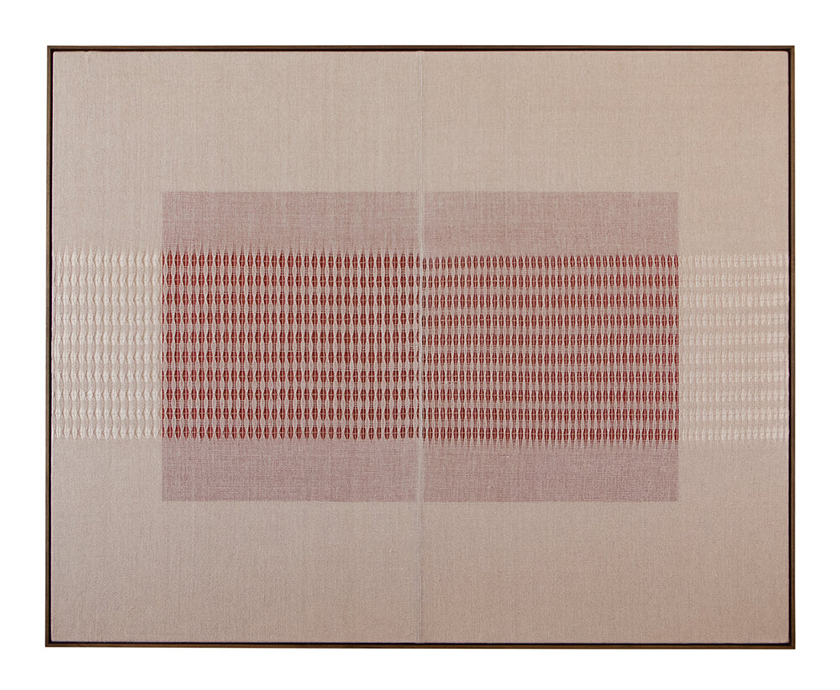
“Madder Flashe Lace” in linen, flashe paint, 2021
Dimensions are: 60” x 48”
Image courtesy of: Rachel DuVall
Courtesy of Duvall’s website, the artist explains the new direction that resulted in six works in addition to two large-scale pieces that she produced while she spent two months at the residency program; “With this work, and with the opportunity to work at the Albers Foundations more broadly, I sought to explore the transparent aspect of my woven works, aiming to push that quality further. My weavings naturally involve optical mixing—where the color of warp and weft overlap with each other. By using different open weave structures and layering this on top of a painted surface, the colors can be pushed in different directions. The through-line for this series has been a focus on color relationships and subtle hue changes through layering. With this series, I wanted to not only reflect the vernacular borne from the Albers’ legacy by introducing painted color blocks to my work, but also especially honor the techniques and knowledge bound into the textile work developed by Anni Albers.”